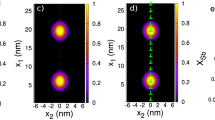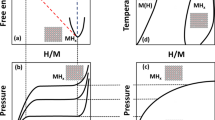Abstract
Isotopic labeling is a powerful tool to evaluatetransport and reaction mechanisms of oxidation. Theevaluation can answer the essential question inhigh-temperature oxidation: which is the dominatingmigrating species? Isotopic labeling can be used in twodifferent ways: analysis of the gas phase and analysisof the oxide formed. By using as-reported,depth-profiling data from the literature, the oxygenexchange was evaluated and compared with oxide growth.Gas-phase analysis was used to evaluate theoxygen-exchange reactions, O2 ↔7H2O, O2 ↔ O2, andO2 ↔ MexOy, inrelation to the oxidation of Si and Fe-Cr-Al alloys in ~10 mbar isotopically-labeledH2O/O2-gas mixtures at 900 to 950°C.The time dependence of the rate of the oxygen exchangewas used to explain the deviation from parabolicoxidation kinetics. The results of this study suggest that atomic oxygen is themigrating species during the oxidation of Si andalumina-forming alloys.
Similar content being viewed by others
REFERENCES
P. Kofstad, High Temperature Corrosion (Elsevier Applied Science, London and New York, 1988).
A. T. Fromhold, Jr, Theory of Metal Oxidation, Vol. 1: Fundamentals (North-Holland, Amsterdam, 1976).
F. P. Fehlner, Low-Temperature Oxidation (J. Wiley, New York, 1986).
H. J. Grabke, M. W. Brumm, and B. Wagemann, Mater. Corros. 47, 675 (1996).
B. E. Deal and A. S. Grove, J. Appl. Phys. 36, 3770 (1965).
F. Fehlner and M. J. Graham, Corrosion Mechanism in Theory and Practice, P. Marcus and J. Oudar, eds. (1995), chap. 4, pp. 123–141.
Special Issue: In Honor of David L. Douglass on the Occasion of His Retirement, Oxid. Met. 44, (1995).
T. Åkermark, Ph.D. Thesis, Royal Institute of Technology, Stockholm, Sweden, 1996.
S. Rigo, Instabilities in Silicon Devices, G. Barbottin and A. Vapaille, eds. (North-Holland, Amsterdam, 1986), Vol. 1, pp. 8–100.
A. Atkins, Rev. Modern Phys. 57, 437 (1985).
Q. Lu, G. Hultquist, K. L. Tan, and T. Åkermark, Surface Interface Anal. 20, 645 (1993).
Q. Lu, Ph.D. Thesis, Royal Institute of Technology, Stockholm, Sweden, 1994.
T. Åkermark and G. Hultquist, J. Electrochem. Soc. 144, 1456 (1997).
T. Åkermark and G. Hultquist, Oxid. Met. 47, 117 (1997).
T. Åkermark, G. Hultquist, and L. Gråsjö, J. Trace Microprobe Technol. 14, 377 (1996).
G. Hultquist, L. Gråsjö, Q. Lu, and T. Åkermark, Corros. Sci. 36, 1459 (19).
L. Gråsjö, Ph.D. Thesis, Royal Institute of Technology, Stockholm, Sweden, 1994.
C.-J. Han and C. R. Helms, J. Electrochem. Soc. 135, 1824 (1988).
J. D. Cawley, J. W. Halloran, and A. R. Cooper, Oxid. Met. 28, 1 (1987).
J. A. Costello and R. E. Tressler, J. Electrochem. Soc. 131, 1944 (1984).
W. J. Quadakkers, H. Holzbrecher, K. G. Briefs, and H. Beske, Oxid. Met. 32, 67 (1989).
H. Beske, W. J Quadakkers, H. Holzbrecher, H. Schuster, and H. Nickel, Mikrochim. Acta II, 109 (1990).
C. Wagner, Z. Phys. Chem. B21, 25 (1933).
G. K. Boreskov, Catalysis Science and Technology, eds. 1982) J. R. Anderson and M. Boundart, chap. 2, pp. 39–137.
G. K. Boreskov and V. S. Muzykantov, Ann. N.Y. Acad. Sci. 213, 137 (1973).
E. R. S. Winter, J. Chem. Soc. A, pp. 2889–2902 (1968).
J. Nováková, Catalysis Rev. J. 4, 77 (1970).
P. W. Atkins, Physical Chemistry, 4th ed. (1990), (a) Chap. 26, pp. 777–813; (b) Chap. 28, pp. 884–902.
Yu. M. Mishin and G. Borchardt, J. Phys. 3, 863 (1993).
E. A. Gulbransen, J. Vacuum Sci. Technol. 17, 109 (1980).
S.-C. Kao and R. H. Doremus, J. Electrochem. Soc. 141, 1832 (1994).
T. Albers, M. Neumann, D. Lipinsky, and A. Benninghoven, Appl. Surface Sci. 70/71, 49 (1993).
D. E. Sykes and A. Chew, Surface Interface Anal. 21, 231 (1994).
L. C. Feldman, in Ion Spectroscopies for Surface Analysis, A. W. Czanderna and D. M. Hercules, eds. (Plenum Press, New York, 1991), chap. 2, p. 358.
F. Rochet, B. Agius, and S. Rigo, J. Electrochem. Soc. 131, 914 (1984).
E. A. Irene, CRC Crit. Rev. Solid State Mater. Sci. 14, 175 (1988).
H. Z. Massoud, J. D. Plummer, and E. I. Irene, J. Electrochem. Soc. 132, 2685 (1985).
N. Cabrera and N. F. Mott, Rept. Progr. Phys. 12, 163 (1949).
R. J. Hussey and M. J. Graham, Oxid. Met. 45, 349 (1996).
J. Jedlinski and G. Borchardt, Oxid. Met. 36, 317 (1991).
D. Delaunay and A. M. Huntz, J. Mater. Sci. 17, 2027 (1982).
Rights and permissions
About this article
Cite this article
Akermark, T. The Use of Oxygen Isotopic Labeling to Understand Oxidation Mechanisms. Oxidation of Metals 50, 167–188 (1998). https://doi.org/10.1023/A:1018832103466
Issue Date:
DOI: https://doi.org/10.1023/A:1018832103466




